Letters from Lodi
An insightful and objective look at viticulture and winemaking from the Lodi
Appellation and the growers and vintners behind these crafts. Told from the
perspective of multi-award winning wine journalist, Randy Caparoso.
'Tis the seasons of Lodi's 2019 vintage (and what happened, month-by-month)
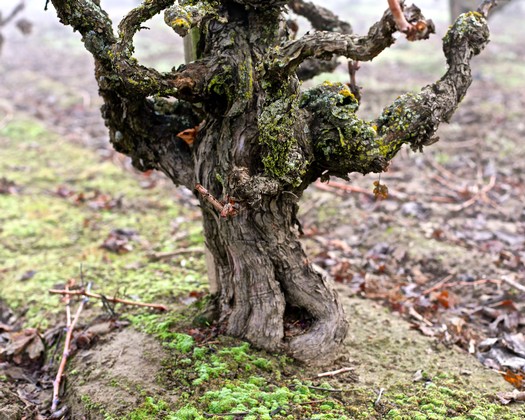
From about a year ago in December 2018: a captivatingly crusty old vine Lodi Zinfandel easing into its yearly, mossy dormancy
Practically everything that happens in Lodi goes according to what happens in vineyards, this agricultural region's most visible industry. As the famous song goes, "To everything (turn, turn, turn) there is a season... and a time to every purpose under heaven."
So when we look back at our favorite images from over the past year, we can revel in the recurring rhythms and familiar chords on top of the distinctions that make a year like 2019... well, uniquely 2019, and Lodi Lodi.
So without further ado, a fresh recollection of some of our fondest memories of vintage 2019, month by month:
January
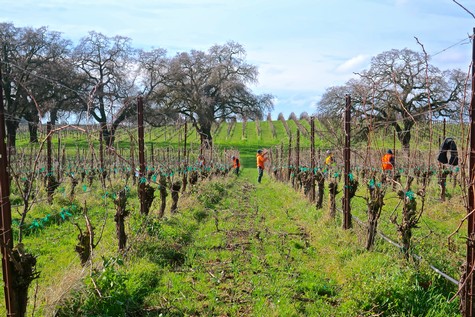
By January virtually all the wines from each previous harvest have finished fermenting and are resting in either tanks or barrels. The most important work is going on in the fields: the pruning of each and every working vine. In Lodi, this is massive work. In California vineyards, there are at least 600 vines planted on every acre. This means there are over 60 million individual vines (more than in California's next two largest wine regions, Napa Valley and Sonoma County, combined) that need to be groomed, all by hand (machine pruning is possible, but is still in an experimental stage) and with unerring skill if each plant is to achieve its optimal level of quality and production.
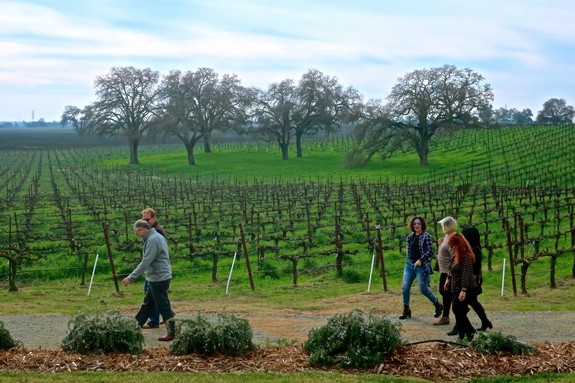
Vineyards, of course, would not exist without wine lovers (like those in the photo above, strolling through Bokisch's Terra Alta Vineyard near Clements). While occasional winter storms may put a damper on things, Lodi's average 44º F. January temperatures are just inviting enough to get visitors out and about to enjoy the vino and sights. And besides, during winter months Lodi vineyards have their own stunning beauty: particularly the gnarly trunks and naked, twisting spurs of vines as old as over 100 years (and there are elder to downright "ancient" vines in Lodi than in any other American wine region), but also in the lush, green uniformity of younger trellised vines standing at attention in endless, level fields or marching up and down pretty, Instagram-worthy hillsides like synchronized troops.
February
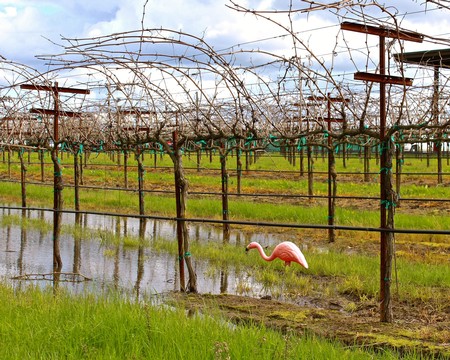
Wet and chilly mid-40º-degree weather events typify Lodi wine country each February, and in 2019 it was no different, maybe even more so, as you can see in the photo above, showing one sardonic winery owner's comment on the swampy conditions during Lodi's 2019 Wine & Chocolate Weekend. There are so many vines to prune in Lodi that it usually takes all the way through March to get it all done, and wet, sticky fields only slow down the process. This factor contributed to a delayed bud break, which in turn pushed back the harvest, and explains why when you look around at the vineyards today (in mid-December) many of the vines are still festooned with leaves, whereas in typical vintages Lodi vines are largely bald by this time of year. But if every vintage were the same, wines wouldn't be nearly as interesting, wouldn't it?

(image courtesy of Lodi social media marketing specialist Frances Siria)
All the same, 2019's Lodi Wine & Chocolate Weekend was as fun and festive as ever, and wines like Lodi Zinfandel tastes so good (and as bouncy as a plush mattress) when the weather outside is damp, or even frightenin'. Speaking of which (slight pause for commercial message), 2020's Lodi Wine & Chocolate Weekend (February 7-9) promises to be even more fun, with the addition of (for the first time!) the addition of Friday night wine dinners at individual wineries (for more details, keep up with lodiwineandchocolate.com).
March
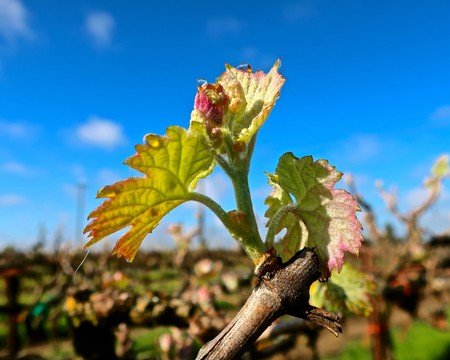
By the end of each March, when day-time temperatures hit 60° (despite nights still hovering around 41°), the sap rises up from the vine roots and the spurs pop off their brown prophylactic sheathes to bust out their tender buds and leaves. Color returns to the vineyards, and now the real magic begins.
April
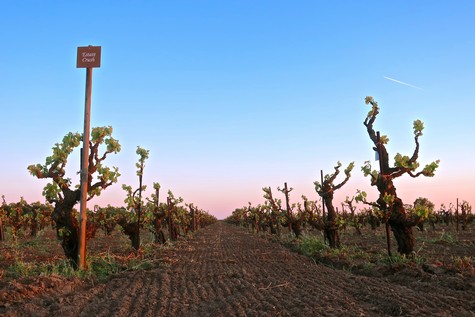
Poets and songwriters love rhapsodizing about April, but in truth, there is a certain ungainliness to vineyards in regions like Lodi. To suppress competition and push vine growth along, the green and colorful carpets of grass and floral cover crops between the vines are unceremoniously mowed down to bare dirt (as in this April 2019 photo of Cinsaut vines in Bechthold Vineyard, Lodi's oldest planting dating back to 1886), and from a distance, the burgeoning shoots popping out of the spurs give the vines something of a bad-haircut look. Still, the days are getting warmer, the plant energy-giving sunlight gets brighter, and cloudless days get steadily more frequent, particularly in Lodi which even saw temperatures hitting the 80ºs by the end of April in 2019.
May

May is a merry month almost everywhere in the Northern Hemisphere, no less in Lodi. All the same, Mother Nature will still keep you on your toes with things like unmerry rainstorms, as we saw during Lodi's annual ZinFest Wine Festival on May 18, 2019 (which didn't keep ZinFesters like in the photo above from enjoying the weekend anyway). While Lodi saw its historic 79°, 80° degree temperatures on many days, we also saw a good number of "odd" events when temperatures barely reached 70° or even 60º. This California Delta-influenced region's growing seasons are defined by its Mediterranean climate, which means dry and balmy summers. "Summer," however, took a few days off during May of 2019, which slowed down vine growth just a tad more; although, in retrospect...
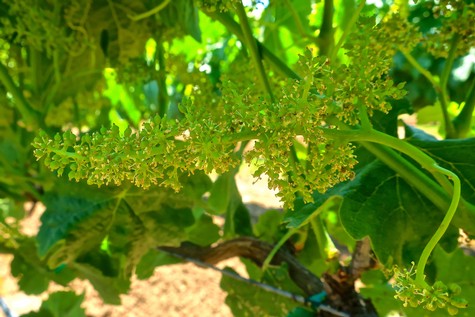
things turned out just fine, as by the end of this year's May merriment Lodi saw most of its vineyards begin to flower (the little yellow blossoms that turn into individual grape berries, as you can see in the photo above, from the last week of the month) with no problemo, during May 2019's perfectly warm weather.
June
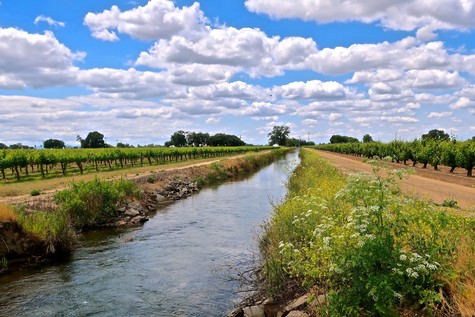
Lodi's June 2019 raced by in fine fashion, under expansive skies lit up by a bright, warm sun, even on cloudier days (as in the photo of the west side Mokelumne River AVA vineyards above). Perfectly healthy grapevine canopies fanned out like peacocks' feathered tails in consistently ideal temperatures (in the upper 80ºs), while growers focused on selecting the shoots and leaves to thin...
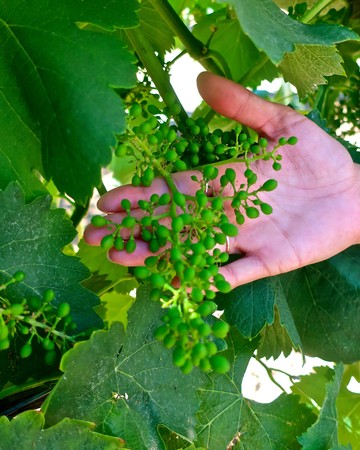
particularly around the fruit zones to allow the emerging, rapidly expanding grape clusters to soak in the sunlight necessary for optimal flavor production (which is concentrated primarily in the skins of grapes), as you can see in this burgeoning cluster of Fiano in Oak Farm Vineyards' estate.
July
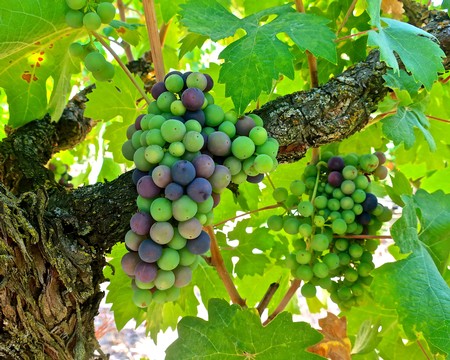
Excitement mounted (okay, "exciting" for us hopeless grape geeks), as 2019 pretty much hit Lodi's average July temperatures of 92°, 93º, slightly lower on some days, other days creeping up to 100°, which wine grapes absolutely love. The elation becomes tangible, or at least visible, in red grapes like Zinfandel (photo above), which go from green to Christmasy-gay colors of red, blue, and purple, which happens during the July phase the French call véraison (wine terms always sound more important in French). Once this happens, it's off to the races, signaling harvest is imminent (usually within 100 days).
August
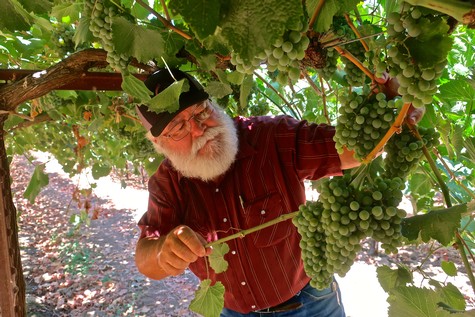
In the photo above, Silvaspoons Vineyards owner/grower Ron Silva is looking at his Alta Mesa-Lodi grown Alvarinho (a Portuguese variant of the Albariño grape) that, in 2019's early August, was less than two weeks away from optimal maturity. In Lodi, August is the month to harvest most grapes for white wines and rosés, since vintners generally prefer grapes with lower sugars (usually around 22°, 22.5º or 23º Brix, i.e. sugar reading) and higher acidity (for crisper balance) for whites and dry rosés, whereas grapes for red wines are picked when they attain at least 23.5º to 24.5º Brix to produce wines of deeper color, fuller body/alcohol, and lower acidity/tartness.
September
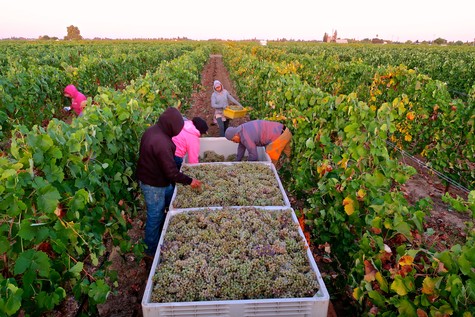
The advantage of Lodi's consistent Mediterranean climate, especially during peak summer months seeing light from the moment the sun sets to the last second of each day, is that it is dependably dry and warm with little risk of the kind of damp or wet weather that typically wreak havoc (like grape rot) in more marginal, challenging parts of the wine world. This, simply, is why there are more premium wine grapes (and a greater variety of premium wine grapes) grown in Lodi than anywhere else in the U.S. In 2019, the last of Lodi's white wine grapes (such as the Acquiesce estate Bourboulenc in the photo above) were picked without anything untoward by mid-September, achieving a higher quality than ever.
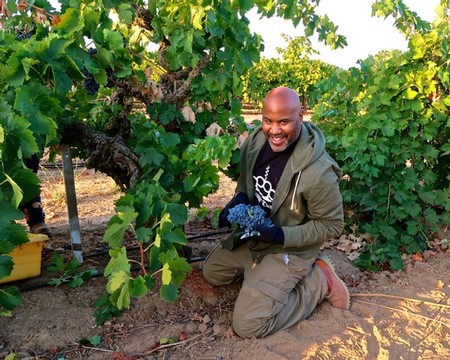
One of the prevalent trends in Lodi is to pick Zinfandel at moderate sugars (24.5° Brix at the most) to attain lower uncut alcohol (below 15%, ideally closer to 14%) as well as more floral, fresher red fruit complexities. In other words, a prettier, more comely style of Zinfandel (as opposed to one that is big and boisterous). Hence, Zinfandel in ancient vine plantings such as Jessie's Grove's 1889 block (in the photo above) were picked in the first half of September 2019 for renowned producers such as Alquimista Cellars, Matthiasson Wines, and of course, Jessie's Grove Winery.
October
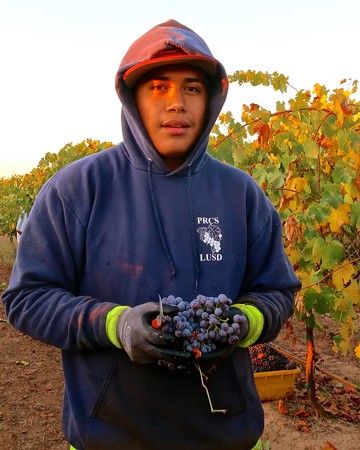
In warm climate, Lodi, October is the month for "later ripening" black-skinned grapes such as Nebbiolo (in the photo above, taken in mid-October in the Anaya family's Potrero Vineyard), the popular Cabernet Sauvignon, the higher acid Barbera grape, exotic varieties like Dornfelder and Graciano, or the red-fleshed Alicante Bouschet. All told the vintage's moderate temperatures yielded grapes of high quality, veering on the side of higher quality than usual, although some growers report slightly lower tonnage than expected. Towards the end of each October, there is always a real possibility of rain events before all the red wine grapes reach optimal maturity or when it is humanly possible to pick them. But in 2019 Mother Nature kindly allowed the Lodi harvest to come to a close without any mishaps, and all the grapes that were going to be picked were picked by the end of the month.
November
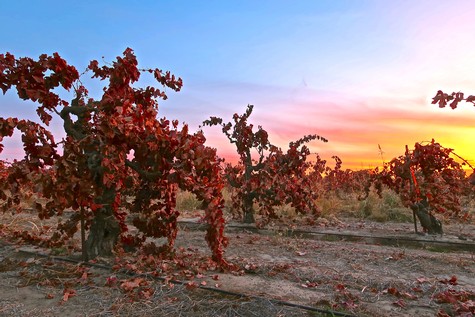
November 2019 followed the script in Lodi wine country. The harvest completed, vineyard managers began to lay down compost (in winery estates, consisting of grape skin pressings from fermented wines) and commence deep watering to give the spent, hard-working vines a good "drink" before transitioning to late fall dormancy commencing once temperatures sink into the 30°s or lower. As it were, it's been a spectacular autumn in terms of foliage colors, such as the crimson fire lighting up the ancient vine Carignan (planted in 1909) pictured above, growing on Lodi's east side.
December
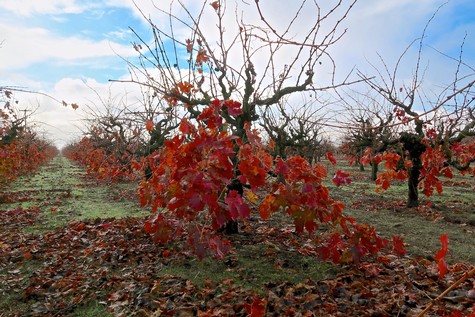
December is typically Lodi's second coldest month, which grapevines welcome to ease into a winter slumber when they can conserve their energy for next year's growth. We have, of course, also seen some replenishing pre-winter storms, and we will no doubt see more in the weeks to come. All the better for plants like old vine Zinfandel (pictured above, this past week between the storms), which will sip the extra water with pleasure the way we do when we raise our toasts with glasses of typically pure, lush, fruit-forward Lodi-grown wines. Looking forward to a prosperous 2020!